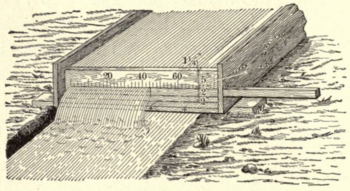Miner's inch

The miner's inch is a unit of flow in terms of volume per unit time, usually in relation to the flow of water. The definition of a miner's inch varies by location.
In hydraulic mining and some forms of placer mining, as well as ore dressing, a large and regular supply of water is needed. The miner's inch is a method of measuring the amount of flow a particular water supply system (such as a flume or sluice) is capable of supplying.
The miner’s inch measures the amount of water that would flow through a slot of a given area at a given pressure (for example, at a head of 6 inches of water, or 1.5 kPa.) In miner's inch the word inch refers to the area of the slot in square inches, while the pressure in inches of water refers to the height of water above the slot. A variable-width slot can be used to modify the flow rate.
Definition
[edit]This section needs additional citations for verification. (January 2024) |
Historically, the unit lacked a firm definition or equivalent measurement, and varied by location, leading to confusion within the mining industry.[1][2] In 1905, its usage in California was standardized.[2] Today, standards vary across jurisdictions, with values between 1⁄60 and 1⁄36 cu ft/s.
| jurisdiction | definition | ||
|---|---|---|---|
| New Zealand | 1⁄60 cu ft/s | 472 mL/s | |
| United States | 1⁄50 cu ft/s | 566 mL/s | |
| 1⁄40 cu ft/s | 708 mL/s | ||
| Colorado | 1⁄38 cu ft/s | 745 mL/s | |
| Canada | British Columbia | 1⁄36 cu ft/s | 787 mL/s |
State regulations sometimes forbid[citation needed] the use of the unit without its being associated with a definition in the same document.
References
[edit]- ^ Placer Mining. Scranton, PA: Colliery Engineering Co. 1897. pp. 76–80.
- ^ a b Wilson, E. B. (1907). Hydraulic and Placer Mining. New York: John Wiley & Sons. pp. 91–92.
